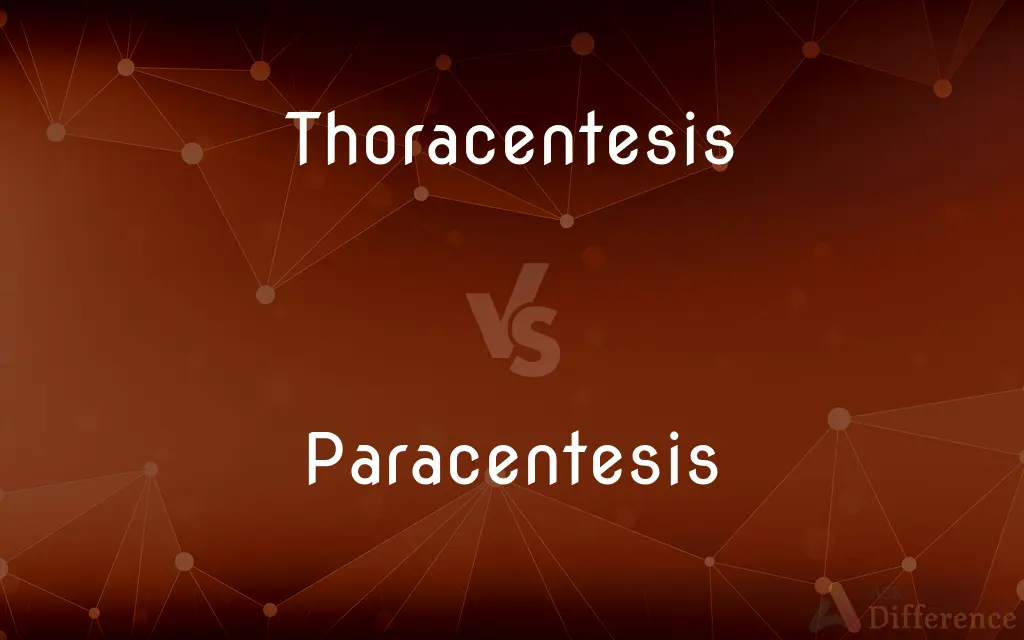Thoracentesis vs. Paracentesis — What's the Difference?
By Maham Liaqat & Urooj Arif — Updated on March 31, 2024
Thoracentesis involves removing fluid from the chest cavity to treat symptoms or diagnose conditions, whereas paracentesis removes fluid from the abdominal area, often for similar reasons.

Difference Between Thoracentesis and Paracentesis
Table of Contents
ADVERTISEMENT
Key Differences
Thoracentesis is a medical procedure aimed at extracting fluid from the pleural space, which lies between the chest wall and the lungs. This is typically done to relieve pressure on the lungs, analyze the fluid for diagnostic purposes, or treat symptoms of various conditions, such as pleural effusion or pneumonia. On the other hand, paracentesis targets the abdominal cavity, specifically to remove fluid buildup known as ascites. This procedure can help diagnose the causes of fluid accumulation, relieve discomfort, and manage symptoms related to liver disease, cancer, or heart failure.
While thoracentesis primarily focuses on issues related to the lungs and chest area, such as dyspnea (difficulty breathing) and chest discomfort, it can also be utilized to diagnose diseases like tuberculosis or lung cancer when the pleural fluid is examined. Paracentesis, in contrast, is often employed in the management of symptoms associated with liver cirrhosis, abdominal swelling, and to prevent complications like spontaneous bacterial peritonitis, indicating a broader diagnostic and therapeutic scope within the abdominal region.
The technique of thoracentesis involves inserting a needle or a small tube into the pleural space under local anesthesia, which requires careful ultrasound guidance to avoid damage to the lungs and surrounding tissues. Whereas paracentesis also uses ultrasound guidance, the focus is on safely accessing the peritoneal cavity to prevent injury to the intestines and other abdominal organs, highlighting the procedural similarities yet distinct anatomical considerations.
Patients undergoing thoracentesis might experience immediate relief from respiratory symptoms, underscoring its role in symptomatic management and its potential diagnostic value. Conversely, paracentesis can lead to significant improvement in abdominal discomfort and mobility, illustrating the impact of removing excess fluid from the abdominal cavity on patient comfort and quality of life.
Thoracentesis and paracentesis, while distinct in their applications, share a common goal of alleviating discomfort and aiding in the diagnosis of underlying medical conditions. They both require skilled medical practitioners to perform safely and effectively, demonstrating the importance of specialized medical procedures in comprehensive patient care.
ADVERTISEMENT
Comparison Chart
Definition
A procedure to remove fluid from the pleural space in the chest.
A procedure to remove fluid from the abdominal cavity.
Primary Purpose
To relieve pressure on the lungs, diagnose conditions, and manage symptoms related to chest and lung issues.
To diagnose causes of abdominal fluid accumulation, relieve discomfort, and manage symptoms associated with abdominal conditions.
Target Area
Pleural space between the chest wall and lungs.
Peritoneal cavity within the abdominal area.
Common Conditions Treated
Pleural effusion, pneumonia, lung cancer.
Liver cirrhosis, ascites, abdominal swelling, cancer.
Procedure Guidance
Typically performed under ultrasound guidance to avoid lung damage.
Often utilizes ultrasound to prevent injury to abdominal organs.
Compare with Definitions
Thoracentesis
Thoracentesis is a procedure to remove fluid from the space between the lungs and the chest wall.
The doctor recommended thoracentesis to treat her pleural effusion.
Paracentesis
Paracentesis involves removing fluid from the abdomen.
Paracentesis was performed to reduce his abdominal swelling.
Thoracentesis
It can relieve symptoms like shortness of breath and chest pain.
After thoracentesis, his breathing improved significantly.
Paracentesis
The procedure is guided by ultrasound for safety.
The use of ultrasound in paracentesis prevents organ damage.
Thoracentesis
The procedure requires precision and care to avoid complications.
Ultrasound guidance during thoracentesis minimizes risks.
Paracentesis
Relief from symptoms can be significant after paracentesis.
Her abdominal pain was greatly reduced following paracentesis.
Thoracentesis
Patients may experience immediate symptom relief post-procedure.
She felt less pressure on her chest after thoracentesis.
Paracentesis
Paracentesis can improve patient comfort and mobility.
He was able to walk easier after the paracentesis.
Thoracentesis
Thoracentesis is also used for diagnostic purposes.
The fluid removed during thoracentesis was sent for analysis.
Paracentesis
It is often used to diagnose and treat ascites.
Analysis of the fluid from paracentesis helped diagnose her liver condition.
Thoracentesis
Thoracentesis , also known as thoracocentesis (from Greek θώραξ thōrax 'chest, thorax'—GEN thōrakos—and κέντησις kentēsis 'pricking, puncture'), pleural tap, needle thoracostomy, or needle decompression (often used term) is an invasive medical procedure to remove fluid or air from the pleural space for diagnostic or therapeutic purposes. A cannula, or hollow needle, is carefully introduced into the thorax, generally after administration of local anesthesia.
Paracentesis
Paracentesis (from Greek κεντάω, "to pierce") is a form of body fluid sampling procedure, generally referring to peritoneocentesis (also called laparocentesis or abdominal paracentesis) in which the peritoneal cavity is punctured by a needle to sample peritoneal fluid.The procedure is used to remove fluid from the peritoneal cavity, particularly if this cannot be achieved with medication. The most common indication is ascites that has developed in people with cirrhosis.
Thoracentesis
(surgery) A medical procedure involving needle drainage of air or fluid from the pleural space.
Paracentesis
(surgery) A medical procedure involving needle drainage of fluid from a body cavity, most commonly the abdomen.
Thoracentesis
The operation of puncturing the chest wall so as to let out liquids contained in the cavity of the chest.
Paracentesis
The perforation of a cavity of the body with a trocar, aspirator, or other suitable instrument, for the evacuation of effused fluid, pus, or gas; tapping.
Paracentesis
Centesis of the belly to remove fluid for diagnosis
Common Curiosities
What is paracentesis?
Paracentesis is a procedure to remove fluid from the abdominal cavity, typically to diagnose the cause of fluid buildup or to relieve symptoms associated with it.
How do thoracentesis and paracentesis differ?
Thoracentesis targets the chest area, specifically the pleural space, while paracentesis is focused on the abdominal cavity.
What is thoracentesis?
Thoracentesis is a medical procedure to remove fluid from the pleural space between the chest wall and the lungs, often for diagnostic or therapeutic purposes.
How are thoracentesis and paracentesis similar?
Both procedures involve the removal of excess fluid from the body to relieve symptoms and help diagnose underlying conditions, using ultrasound guidance for safety.
How long does thoracentesis take?
Thoracentesis usually takes about 15 to 30 minutes, depending on the amount of fluid to be removed.
What conditions can thoracentesis help diagnose?
Thoracentesis can help diagnose conditions like pleural effusion, pneumonia, and lung cancer by analyzing the fluid collected.
Is thoracentesis painful?
Patients may experience discomfort during thoracentesis, but local anesthesia is used to minimize pain.
Is paracentesis painful?
Like thoracentesis, paracentesis involves discomfort, but pain is typically managed with local anesthesia.
What conditions can paracentesis help diagnose?
Paracentesis is used to diagnose conditions related to fluid buildup in the abdomen, such as liver cirrhosis, ascites, and abdominal cancers.
What are the risks of thoracentesis?
Risks include infection, bleeding, and lung puncture, though these are rare with proper technique and guidance.
Can paracentesis cure the underlying disease?
Like thoracentesis, paracentesis does not cure the underlying condition but helps manage symptoms and aids in diagnosis.
How long does paracentesis take?
Paracentesis duration varies but generally falls within the same range as thoracentesis, around 15 to 30 minutes.
What are the risks of paracentesis?
Similar to thoracentesis, risks include infection, bleeding, and damage to internal organs, but these are minimized with ultrasound guidance.
Can thoracentesis cure the underlying disease?
Thoracentesis is a symptomatic treatment and diagnostic tool; it does not cure the underlying disease but can provide relief and information.
Who performs thoracentesis and paracentesis?
These procedures are performed by trained healthcare professionals, often in hospitals or clinics, under sterile conditions.
Share Your Discovery

Previous Comparison
Squad vs. Squadron
Next Comparison
Biography vs. BackgroundAuthor Spotlight
Written by
Maham LiaqatCo-written by
Urooj ArifUrooj is a skilled content writer at Ask Difference, known for her exceptional ability to simplify complex topics into engaging and informative content. With a passion for research and a flair for clear, concise writing, she consistently delivers articles that resonate with our diverse audience.
















































